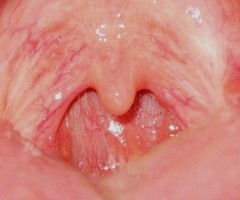As you look in the mirror at the inside of your mouth, you will see a bag-like sac hanging above your mouth. This fleshy structure dangling above your throat is called uvula which literally means "little grape" in Latin.

What is a Uvula?
The uvula is a small piece of teardrop-shaped tissue which hangs from the top of the rear part your mouth. It is also known as palatine uvula since it is part of the soft palate (the back part of the roof of the mouth) connected by a muscle known as muscularis uvulae. It usually measures 5-25 mm long, with some people having uvulas that are more oval-shaped.
The uvula is made of various types of tissues. It contains glandular tissue, connective tissue, and muscle tissue. It is generally pinkish in color with possible variations in some people having red, purple, or brown uvula.
As part of the oral cavity, the uvula can be affected by certain medical conditions such as uvulitis or inflammation of the uvula and the presence of white spots or bumps. A person can also develop a deviating, bifid, or elongated type of uvula.
There are instances in which a person's uvula needs to be removed. It usually happens when it is too big that it affects breathing. In some cases, the uvula can cause a person to snore or to suffer from obstructive sleep apnea. Fortunately, it is possible for humans to live without uvula.
READ ALSO: Viral TikTok Trend Mouth Taping That Claims To Solve Bad Breath Makes No Sense, Dental Expert Says
What Does the Uvula Do?
Experts still do not fully understand the major reason why we have uvulas. The fact that only humans and baboons have this dangling flesh in the mouth adds to the mystery regarding its real purpose. Throughout history, people have interesting and contradictory ideas about the function of uvulas, as compiled in the 1992 study entitled "The Riddle of the Uvula" published by otolaryngologist Yehuda Finkelstein.
The paper describes that the human uvula is larger and is more complex than in baboons. Finkelstein and his colleagues argue believed that this tiny flesh in our mouth plays an important role in speech which distinguishes humans from the rest of the animal kingdom. It was also noted that uvula can make a large amount of saliva which can be excreted in a short amount of time.
It was found that uvula is an important component of speech since it is used in making uvular sounds and it also affects voice quality. However, this function is noticeable enough to prevent the traditional of removing uvula in some culture. In 1965, a physician in northern Morocco named Charles A. Apffel reported his observations where most of his patients in the area had no uvula. He found out that the absence of uvula is attributed to surgical removal which has been practiced since Medieval times. This tradition involves operation carried out by caretaker, sexton, or a barber to children or newborn babies of both sexes.
Another report was published by science journalist Robbie Gonzales where he asked speech-language pathologist Katie Plattner regarding the real purpose of uvula. Plattner describes the theory on the function of uvula in increasing surface area to trigger gag reflex. The gag theory is supported by a review in which G.S. Bassi pointed out the role of uvula as one of the five zones that trigger gag reflex.
RELATED ARTICLE: Should You Rinse Your Mouth After Brushing Your Teeth?
Check out more news and information on Mouth in Science Times.














